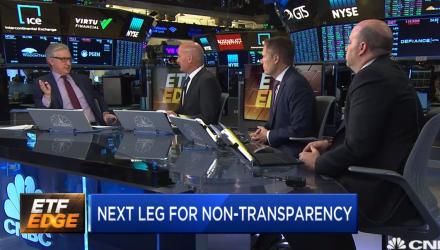Last week, the SEC approved active equity ETF models that would not be required to disclose portfolio holdings daily. That’s a big move for non-transparent ETFs, which is the topic of conversation during Monday’s ETF Edge show hosted by CNBC’s Bob Pisani.
With this approval, active managers will be allowed to move from a mutual fund to an ETF wrapper, while allowing them to keep their strategies hidden from shareholders. These non-transparent ETFs would move the disclosure of portfolio holdings from a daily event to a quarterly one.
The question now becomes whether or not active management will do any better under an ETF wrapper, after seeing outflows for years. Pisani shits the conversation over to Dan Draper, global head of ETFs at Invesco, who believes there is an argument to be made for having non-transparent ETFs.
From Invesco’s perspective, the idea is to offer all the different types of potential solutions to clients. In today’s world, while there isn’t huge pent-up demand, there is the potential to take the very best of active management security selection and utilize a more efficient tax-efficient wrapper at lower costs.
“I think for some clients that can really make sense,” Draper states, adding, “Specifically here, the approvals coming in first for US equities, but the potential for other asset classes like fixed-income, etc., so it’s a very important development, but I think the education and role out will take time.”
Concerns For Front-Running
Pisani then asks if concerns for front-running are justified, given how it’s the basis for wanting non-transparent ETFs. CFRA’s Todd Rosenbluth believes it depends on the portfolio. He notes Davis Advisors as an example, which runs transparent, actively managed equity. Their strategy is low turnover, a relatively concentrated portfolio of large cap stocks.
If the investor is more complicated than that, they’d want to be able to do it. However, it’s the big firms that can change things if they go more in aggressively, launching existing strategies, but turning them into an ETF wrapper, which puts them in a positive space for 2020.
ETF Trends CEO Tom Lydon joined the conversation, adding how looking at the $8.6 trillion in equity mutual funds, it’s known that $4.6 trillion is passive, $4 trillion is active, and then there’s a lot of long-term relationships there where these companies want to be able to make offers in either a mutual fund or ETF format.
“It comes down to choice,” he said.
In regards to whether the lower cost will help investors move over to non-transparent ETFs, Lydon responds by noting how there’s been a ten-year bull market, and passive has been on top.
“Will it ever revert to the mean where active comes back? If it does, and these companies are betting on it, in this ETF wrapper, and especially because they’ve got a lot of marketing dollars behind it, I think that there’s a way for them to get some flows.”
Watch This ETF Edge Discussion Of Non-Transparent ETFs:
For more market trends, visit ETF Trends.


